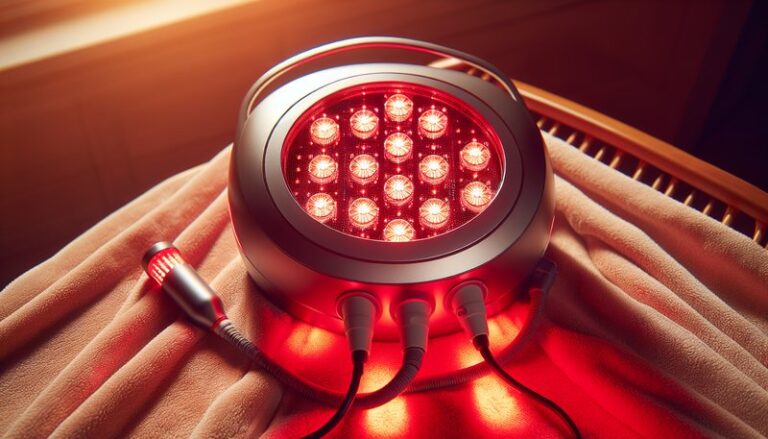What Is The Difference Between Infrared And Red Light Therapy?
Are you curious about the various types of light therapies and their unique benefits? Understanding the distinctions between infrared and red light therapy can help you make informed decisions about your wellness journey.
Discover our review on Can Red Light Therapy Aid Weight Loss?
This article will clarify the differences between infrared and red light therapy, outline their respective benefits, address common misconceptions, and present alternatives available for those exploring light therapy options.
Key Takeaways
- Infrared therapy penetrates deeper into tissues than red light therapy, making it beneficial for pain relief and muscle recovery.
- Red light therapy is commonly used for skin health and wound healing, focusing more on surface-level skin issues.
- Both therapies can be integrated into wellness routines, but they serve different health objectives.
What is Infrared and Red Light Therapy?
Light therapy involves the use of specific wavelengths of light to promote various health benefits. Infrared light typically falls beyond the visible spectrum, with wavelengths ranging from 700 nm to 1 mm. It is known for its ability to penetrate deeper into the skin and tissues, providing warmth and promoting circulation.
Red light therapy, on the other hand, uses wavelengths between 600 nm and 700 nm, which are visible to the human eye. This type of therapy is primarily aimed at enhancing skin health and facilitating the healing of superficial wounds.
Both therapies work by stimulating cellular processes, improving circulation, and advocating healing. They employ different mechanisms to achieve distinct outcomes.
What are the Benefits of Infrared and Red Light Therapy?
Light therapy offers a range of benefits depending on the type used. The following sections will delve deeper into the specific benefits of each therapy.
Benefits of Infrared Light Therapy
Infrared light therapy is particularly known for its deep tissue effects:
- Pain Relief: Infrared light penetrates deep into muscles and joints, promoting relaxation and alleviating pain from conditions such as arthritis or muscle strains.
- Enhanced Circulation: The warmth from infrared light encourages blood flow, helping with quicker recovery from injuries and supporting healing.
- Detoxification: Infrared therapy may assist in body detoxification by promoting sweating and encouraging the excretion of toxins.
Benefits of Red Light Therapy
Red light therapy is celebrated for its surface-level advantages:
- Skin Health: Red light promotes collagen production, improving skin elasticity and reducing fine lines and wrinkles.
- Wound Healing: It speeds up the healing process for cuts and minor injuries by increasing circulation and cellular activity in the affected area.
- Hair Growth: Studies suggest that red light therapy can stimulate hair follicles, offering a non-invasive option for those experiencing hair loss.
Is it Possible to Combine Infrared and Red Light Therapy?
Yes, it is entirely possible and often beneficial to combine both infrared and red light therapy. Many individuals find that using both types enhances overall health and wellness.
What are the Advantages of Combining Both Therapies?
- Comprehensive Healing: Utilizing both therapies allows for addressing surface and deeper issues simultaneously, offering a holistic approach to treatment.
- Versatility in Applications: Incorporating both types can effectively target various conditions, such as skin health, muscle pain, and overall wellness.
- Increased Efficiency: Using red and infrared light together can streamline treatment sessions, maximizing benefits in less time.
What are the Disadvantages of Combining Both Therapies?
- Cost: Accessing devices or treatments that incorporate both therapies may be more expensive than opting for just one type.
- Complexity: Some individuals may find it challenging to determine the appropriate timing and settings for each therapy type, requiring professional guidance.
What are the Things to Consider Before Choosing Light Therapy?
Before embarking on a light therapy journey, there are significant considerations to bear in mind.
Skin Sensitivity
It’s essential to assess your skin’s responsiveness to light therapy. Individuals with sensitive skin may need to approach treatment with caution and start with shorter sessions to gauge their tolerance.
Health Conditions
Consulting with a healthcare professional is crucial, especially for individuals with underlying health conditions or those taking medications that could be affected by light therapy.
Device Quality
Investing in high-quality light therapy devices is vital to ensure effective treatment. Research brands, read reviews, and consider clinical-grade options for optimal results.
What are the Alternatives to Light Therapy?
If light therapy isn’t suitable for you, several alternative options are available.
Acupuncture
Acupuncture is a time-tested practice that addresses various health issues by stimulating specific points on the body, promoting healing, and alleviating pain.
Massage Therapy
Massage therapy helps with muscle relaxation, pain relief, and enhancing circulation, providing similar benefits to light therapy without the use of light.
Physical Therapy
For those recovering from injuries or chronic pain, physical therapy employs targeted exercises and treatments to promote healing, making it an effective alternative.
Conclusion: Is it Recommended to Use Infrared or Red Light Therapy?
Both infrared and red light therapy offer unique benefits tailored to different health needs. If you’re seeking deep tissue relief, infrared therapy may be your best bet, while red light therapy is suited for surface-level concerns like skin health. As with any health intervention, it’s advisable to consult with a healthcare professional to determine the most suitable approach for your specific needs.
Read our full coverage Does Red Light Tan?
Frequently Asked Questions
What types of conditions can benefit from infrared and red light therapy?
Infrared therapy is primarily beneficial for pain relief and muscle recovery, while red light therapy is excellent for skin conditions, wound healing, and enhancing hair growth.
How long should I use infrared or red light therapy?
Treatment duration can vary, but general recommendations suggest sessions lasting between 10 to 30 minutes, depending on the device and the specific condition being treated.
Are there any side effects associated with light therapy?
Most individuals experience minimal to no side effects. However, overexposure can cause temporary skin irritation or discomfort; it’s wise to start with shorter sessions to gauge your body’s response.
Can I perform light therapy at home?
Yes, several devices are available for home use, provided they are certified and meet safety standards. However, proper guidance on usage is essential for best results.
Is there scientific evidence supporting the efficacy of light therapy?
Yes, numerous studies support the effectiveness of both infrared and red light therapy for various conditions. However, continued research is essential to broaden understanding and optimize treatment methods.






